What to plant along the fence?
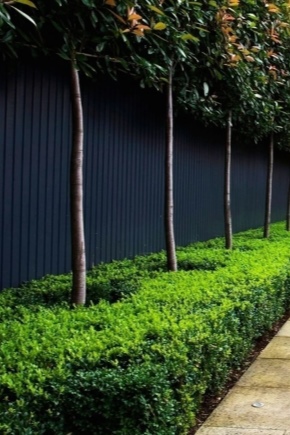
The problem of planting on a site arises either shortly after its acquisition, at the design stage, or during the redevelopment of the inhabited territory. Natural conditions - the structure and composition of the soil, the depth of the groundwater, the relief, and much more, can dictate their limitations. In addition, the biological and ecological characteristics of the planted plants will have to be taken into account. The legal aspect also plays an important role. Will there be conflicts with neighbors in the future due to the shading of their territory?
You also need to consider whether the root system will damage the foundations, communications and structures, both existing and planned. And, of course, when organizing plantings along hedges, the aesthetic side of the issue is important - the selection of crops from a decorative point of view.
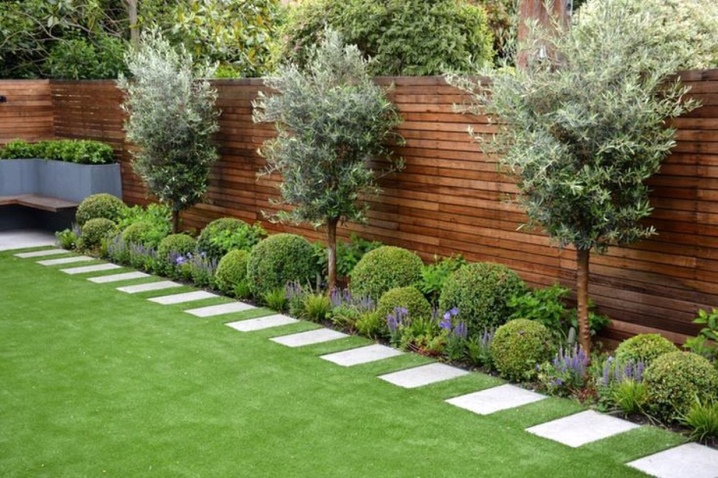
What can you plant?
Often you want to plant something along the fence, for example, in the country, as soon as possible. In this case, one must be prepared for possible problems due to the unexpectedly fast or, conversely, slow growth of some elements of such spontaneous plantings, which will lead to their uneven growth and a rather rapid loss of any decorative effect. Planting tree crops without taking into account their future changes may necessitate the removal of individual branches or even entire trunks, which also will not bring the plantings closer to their ideal appearance.
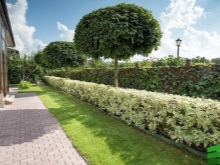

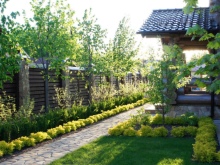
Trees
Trees planted near fences are an excellent barrier to dust and gases from the roadway. In addition, trees can be a good basis for a hedge, blocking the view of the site from neighbors.
Conifers can decorate a blank fence made of stone (brick) or corrugated board: different types of fir trees, thuja, junipers. Fruit trees are more suitable for wooden fences: apple trees, pears, plums, in the southern regions - apricot. In addition to undeniable decorativeness during the flowering period, they delight with fruits in the second half of summer, and in autumn they decorate the space with bright crowns.
However, they require special care, as they become tasty prey for various insect pests that can negate any decorative effect of such plantings.

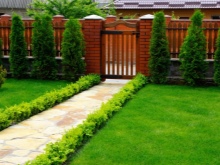
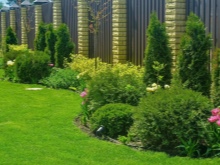
To avoid unpleasant emotions, it is better to plant valuable breeds inside the site, otherwise a lot of precious time will be spent on ineffective protection of seedlings from both possible damage and theft. Young conifers often suffer during the pre-New Year period.
Surveillance cameras or their dummies can save the situation, but they will no longer restore the damaged plantings, and new trees will have to be planted in the spring, which will definitely lag behind the previously planted counterparts.
Having planted trees near the fence, it is important to remember that over the years they can change significantly, causing shading of their own or a neighboring area. Overgrown crowns can very noticeably change the moisture regime of structures, which will cause premature aging of wooden elements, and the root system can damage foundations, walls and communications over time.
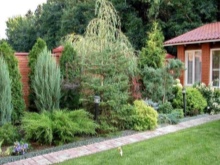
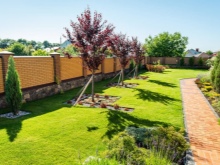
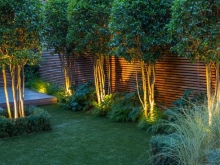
Shrubs
Shrubs are devoid of many disadvantages of tree crops. They can form the basis of a hedge, but they will never cause such intense shading. Most species have a significantly shorter lifespan than trees, but many can easily thrive, cloning themselves in numerous shoots that, with proper care, eventually replace the mother plant.
Fast-growing ornamental shrubs, unlike trees, will help form a hedge much earlier. Long-flowering aromatic varieties - lilac, barberry, ornamental viburnum and many others, can become the basis of mixborders in combination with herbaceous crops and flowers.
Curly species, for example, wild grapes and others, in one season can transform a blank fence made of brick or stone, perfectly emphasizing the texture of a wooden fence.
Thorny bushes - hawthorn, wild rose, including various roses, gooseberries, barberry, can indicate the zoning of the territory even in the absence of a full-fledged fence or in the presence of a low zoning hedge.
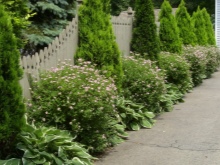
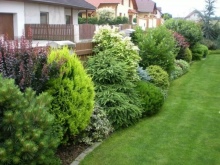
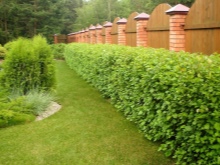
Flowers
Planting flowers along fences and hedges, even in vegetable gardens, is a long-standing folk tradition. On the one hand, this has always been a manifestation of the desire to ennoble space, and on the other, one of the ways to replace weeds with something beautiful and, in the opinion of the hostess, undoubtedly more useful.
Homemade flower beds along fences planted with annual flowers usually require careful weekly maintenance. It is no secret that this does not repulse flower growers at all, but, on the contrary, attracts with the need for constant creativity and creative activity. But it is worth for some reason to weaken your attention, and such flower beds quickly turn into a neglected wasteland with protruding dried shoots and fragrant weeds.
It is the impossibility of daily care that causes the search for perennial flowers and herbs for planting along fences and fences. Decorative loaches will help to refine any fence, including an unpresentable mesh netting. And the species that form clumps perfectly fill the mixbroder, creating a background for low-growing shrubs or tall flowering grasses (gladioli, mallow, dahlias).
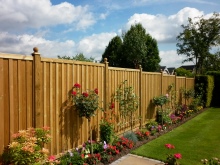
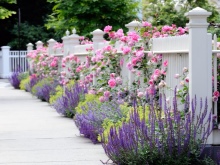
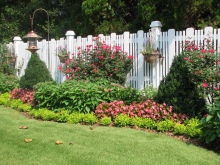
How do I create a composition?
Fence decoration is an important creative component, often present in the subconscious of the owner of any land plot. Creating a composition is especially important in the corner of the site. The options for this design can be very diverse. And their aesthetics are often limited to the ideas and capabilities of the creator, which, to be sure, are far from always ideal.
Of course, if plantings are carried out to decorate a small summer cottage front garden, then such an amateur approach may be justified, and there will be few complaints about such a landscape design.
But if it is necessary to improve the fence of a country house or serious land tenure, the plantings must correspond to the status.

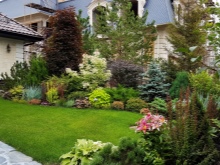

In this case, it is better to use the services of specialists who can develop a planting scheme, taking into account the age and seasonal changes in the planted plants. Besides, it is necessary to conduct a preliminary study of soils regarding their chemical and lithological composition and moistening with groundwater. Plants for light soil will never develop fully on clay soil, and vice versa, moisture lovers planted on sandy soil will experience constant stress, and oppressed plants look rather repulsive and in no way enhance any fences.
Microclimate is often a limiting factor. If a blank fence, for example, made of brick or stone, creates a shade for most of the daylight hours, it is pointless to plant light-loving plants.No matter how much the owner of the site likes them, such plantings will not be able to grow in full force - this is a reality with which not everyone wants to put up and year after year they try to grow on the shady side what should grow in the bright sun.
Often the situation is exactly the opposite, when shade-loving species try to adapt to bright light and constantly high temperatures.
But there is also a third option for the development of events - mixing of forest shade-loving species with lovers of bright light - the descendants of steppe plants.
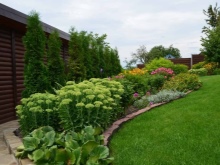

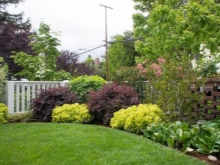
To avoid the annoying mistakes described above, before planning the plantings, you should familiarize yourself with the features and requirements for the habitat of various plants - applicants for creating compositions and mixborders.
But that's not all. It is important to consider possible air flows on the site. Some plants may suffer from cold streams from water bodies or from nearby forests.
The choice of plants for planting can also be influenced by the material from which the fence is made. So, a fence made of corrugated board in the summer heats up a lot, reflecting heat to the plants located nearby. Locally, near the fence, the temperature can rise to tropical indicators unthinkable in the temperate zone. At the same time, it can even be cool in the depths of the site.
It is clear that an increase in temperature causes abundant evaporation from the surface of the leaves, which can be another cause of stress and inhibited growth of plantings near a blank metal fence.
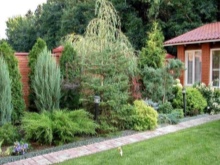
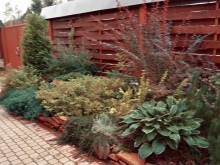
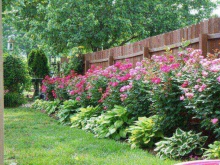
A solid fence made of brick or natural stone requires serious soil preparation, comparable to the foundation, which can significantly affect the distribution of groundwater - this should also be taken into account when planning plantings. By blocking the natural runoff that has been forming for hundreds of years, it is possible to create a zone of increased moisture. At the same time, very close, for example, on the other side of the fence, a zone of local moisture deficiency may arise.
Of course, a wooden fence looks and interacts most organically with any plantings, and if it is also blown, for example, from a picket fence, this is perhaps the best combination of a fence and plantings. It is the search for a possible compromise between the desire of the owner of the site to protect himself as much as possible from noise and from prying eyes and the needs of the plants of his hedge - the main task of a landscape designer, professional or amateur, when landscaping the area of the site and planning plantings along the fences.
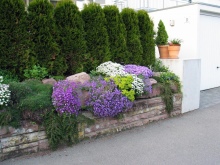
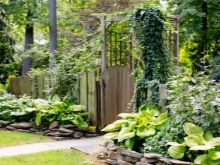
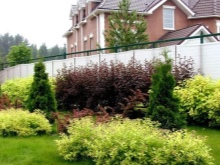
Features of landing from the side of the street
It has already been noted that it is better not to plant especially valuable plants along the outer side of the fences, this can provoke their theft or damage, it will require significant costs for organizing monitoring, in general, it will have a noticeable effect on the comfort of living. Better to do with unpretentious trees:
- poplar;
- maple;
- Birch;
- Rowan.
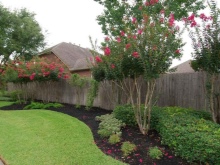
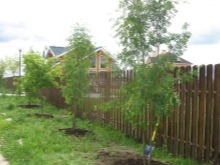

The same hardy shrubs are also suitable:
- lilac;
- barberry;
- acacia (caragana).
The influence of the fence on the microclimate remains the same as on the territory of the site, we will not talk about it separately.
At the same time, one must remember about the growth of plantings over the years and take into account the location of power lines and other communications. Otherwise, there is a danger that the utilities will independently solve the problem by sawing your trees, which will in no way give them decorative effect.
You also need to take into account the location of sidewalks and possible interference with passing vehicles, as this can also cause unpleasant interest from the relevant services.
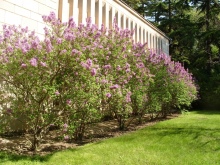
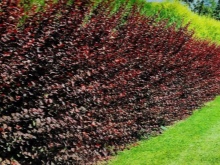

Plant selection tips
For planting along the fences of the site, you can offer the following plants.
- On the sunny side, to create the basis of a mixborder, plants with pubescent leaves are suitable - chisel, decorative wormwood, ornamental cereals, bulbous.Real heat-loving plants are not suitable for such plantings, despite warming up in summer, temperatures can be very low at night and in other seasons.
- In the foreground, you can plant low-growing perennials, for example, thyme, allisum. Some indoor plants can be planted along the fence in the summer: azalea, begonia, bougainvillea. Well suited for planting in the sun roses, petunia, balsam.
- It is better to plant more hardy plants in the shade. In this place, snow falls earlier and lasts longer, more moisture. Forest shrubs are suitable for such places: derain, euonymus, honeysuckle, hawthorn, viburnum, currant, elderberry, hydrangea, various climbing plants.
- From tree crops, sea buckthorn, willow, and sucker will perfectly take root. Conifers can also become the basis of tree plantations.
- The herbaceous base will be created by ferns, hosta, periwinkle, saxifrage, lungwort, geraniums, shade-loving cereals.

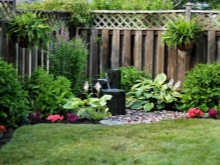
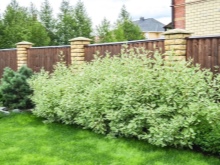







































































































The comment was sent successfully.